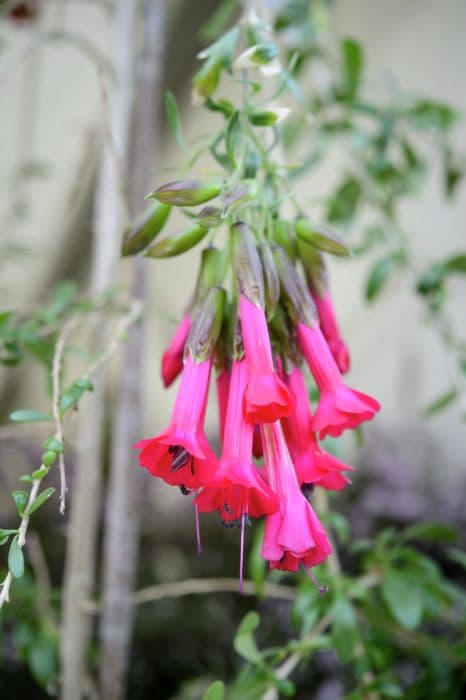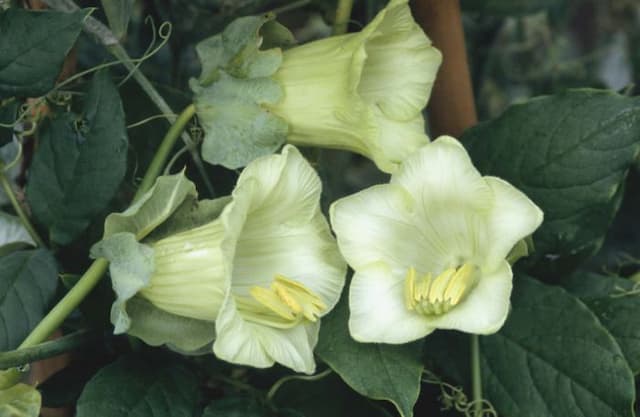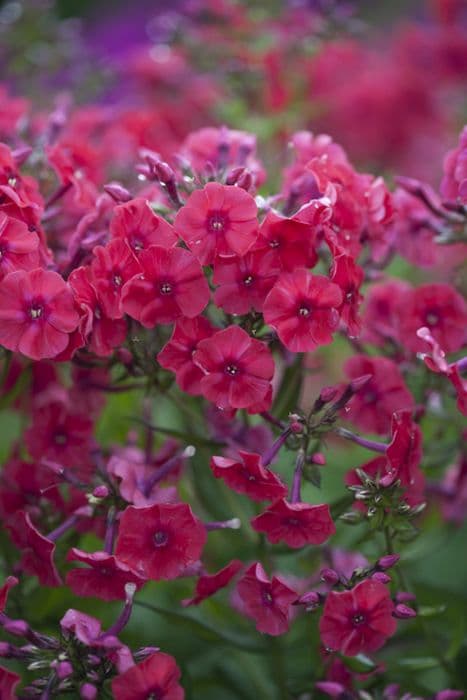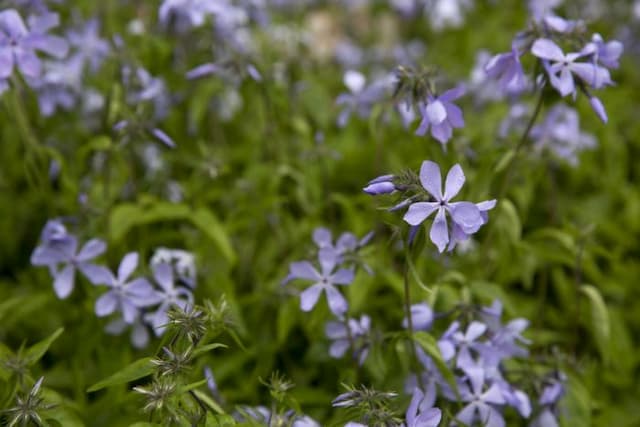Jacob's Ladder Polemonium yezoense var. hidakanum 'Purple Rain'

ABOUT
'Purple Rain' is a variety of Jacob's ladder that showcases striking feathery foliage and an abundance of bell-shaped flowers. The leaves present a ladder-like formation, consisting of numerous small, elliptical leaflets neatly arrayed along each side of a central stem, lending the plant its common name. What sets 'Purple Rain' apart is the unique coloring of its foliage, which typically displays a deep green hue infused with purplish tones. The flowers are the most attractive feature. They cluster at the top of erect, slender stems, forming a loose, open bunch. Each individual blossom is delicate, with an intricate structure. The flowers have a funnel form and are colored in a bold, violet-blue shade, which gives this plant a distinguished appearance among garden flora. The floral display occurs in late spring to early summer, offering not only visual appeal but also attracting pollinators such as bees and butterflies to the garden. Overall, 'Purple Rain' Jacob's ladder is noted for its ornamental foliage and its striking purple-hued flowers, which together create a visually appealing display in gardens, borders, and as part of a mixed perennial planting.
About this plant
 Names
NamesFamily
Polemoniaceae.
Synonyms
Purple Rain Jacob's Ladder, Purple Rain Polemonium.
Common names
Polemonium yezoense 'Purple Rain', Polemonium yezoense var. hidakanum.
 Toxicity
ToxicityTo humans
Jacob's Ladder 'Purple Rain' has no known significant toxicity to humans. It is generally considered safe, and there are no commonly reported symptoms of poisoning from ingesting this plant. However, it is generally advisable to avoid eating ornamental plants as a precaution.
To pets
Jacob's Ladder 'Purple Rain' is not known to be toxic to pets either. There are no specific symptoms associated with poisoning because it is typically not considered poisonous to cats, dogs, or other domestic animals. Nonetheless, it's always a good idea to prevent pets from ingesting plants not intended for consumption to avoid any potential gastrointestinal upset.
 Characteristics
CharacteristicsLife cycle
Perennials
Foliage type
Deciduous
Color of leaves
Green
Flower color
Blue
Height
1-2 feet (30-60 cm)
Spread
1-2 feet (30-60 cm)
Plant type
Herb
Hardiness zones
3
Native area
Japan
Benefits
 General Benefits
General Benefits- Aesthetic Appeal: Adds vibrant purple flowers to gardens, creating visual interest and color contrast.
- Attracts Pollinators: Flowers are known to attract bees and butterflies, which are beneficial for pollination.
- Drought Tolerance: Once established, it has a level of drought resistance, reducing the need for frequent watering.
- Easy to Grow: It's considered to be easy for gardeners to cultivate, making it suitable for beginners.
- Cold Hardy: It can survive in colder climates, broadening the regions where it can be grown successfully.
- Wildlife Habitat: Provides a natural habitat and food source for local fauna, especially insects like bees.
- Low Maintenance: Requires minimal upkeep compared to more demanding plants, saving time and effort.
- Fast Growth: It has a relatively fast growth rate, allowing for quicker establishment and coverage.
- Seasonal Interest: Offers a succession of blooms from late spring to summer, contributing to season-long garden interest.
 Medical Properties
Medical PropertiesThis plant is not used for medical purposes.
 Air-purifying Qualities
Air-purifying QualitiesThis plant is not specifically known for air purifying qualities.
 Other Uses
Other Uses- Jacob's Ladder 'Purple Rain' can be used as a natural dye source. The flowers and leaves may yield varying shades when used in fabric dyeing.
- A live Jacob's Ladder 'Purple Rain' plant can be used in a classroom setting to teach children about botany and the life cycle of plants.
- The plant can serve as an inspiration for artists and designers, with its striking foliage and flower colors influencing color palettes in various creative fields.
- It is possible to incorporate dried Jacob's Ladder 'Purple Rain' flowers into potpourri mixtures for a subtle fragrance and a touch of color.
- The plant can be used in photography to create intriguing and vibrant background elements for close-up shots of insects and other small wildlife.
- Jacob's Ladder 'Purple Rain' can be utilized in theme gardens, such as a purple-themed garden, to emphasize color coordination and design.
- Pressed or dried flowers of Jacob's Ladder 'Purple Rain' can be used in scrapbooking or other paper crafts as decorative elements.
- The unique pattern of the leaves can be used in casting concrete garden stepping stones, where the relief of the leaves creates an artistic impression.
- Blossoms from Jacob's Ladder 'Purple Rain' can be used to adorn serving plates in high-end culinary presentation, as long as one ensures they are free from pesticides and safe for such use.
- Jacob's Ladder 'Purple Rain' can be a model organism for amateur or professional breeding programs aimed at developing new ornamental plant varieties.
Interesting Facts
 Feng Shui
Feng ShuiThe Jacob's Ladder is not used in Feng Shui practice.
 Zodiac Sign Compitability
Zodiac Sign CompitabilityThe Jacob's Ladder is not used in astrology practice.
 Plant Symbolism
Plant Symbolism- Healing: Polemonium, also known as Jacob's Ladder, is often associated with health and healing due to its medicinal properties in some species within the genus.
- Connection to the Divine: The common name Jacob's Ladder suggests a connection to heaven or the divine, based on the biblical story of Jacob dreaming of a ladder reaching to heaven.
- Spiritual Thought: The stair-like arrangement of the leaves of the Jacob's Ladder plant might symbolize progress in spiritual understanding or the steps toward enlightenment.
- Peace: The gentle and calming appearance of Jacob's Ladder flowers may symbolize peace and tranquility.
 Water
WaterJacob's Ladder 'Purple Rain' should be watered deeply once a week, ensuring that the soil is kept consistently moist but not waterlogged. During the growing season, this could equal approximately one inch of water which translates to about 0.6 gallons for an average-sized plant. In hotter, drier climates, increase the frequency of watering to prevent the soil from drying out completely. Reduce watering in the winter when the plant is dormant. Over-watering can lead to root rot, so it's important to ensure good drainage.
 Light
LightJacob's Ladder 'Purple Rain' thrives best in partial to full shade conditions. It prefers a spot that is shielded from the intense afternoon sun, especially in hotter climates. Generally, a location that receives filtered sunlight or morning sun with afternoon shade is ideal for promoting healthy growth without scorching the foliage.
 Temperature
TemperatureJacob's Ladder 'Purple Rain' can survive in temperatures as low as 20°F and as high as 75°F but prefers a cooler climate within that range. The ideal temperature conditions are between 60°F and 70°F for optimal growth. Plants should be protected from harsh winter winds and excessively hot temperatures.
 Pruning
PruningJacob's Ladder 'Purple Rain' benefits from pruning to remove spent flower stalks and to encourage a second bloom. Prune immediately after the first flowering has finished, which typically occurs in late spring or early summer. Pruning can also involve thinning out crowded growth to improve air circulation and prevent disease. Some gardeners also cut the plants down to the ground in fall or late winter to keep the foliage fresh.
 Cleaning
CleaningAs needed
 Soil
SoilJacob's Ladder 'Purple Rain' prefers fertile, well-draining soil with plenty of organic matter. A mix containing loam, compost, and peat or leaf mold can create a rich base. The ideal soil pH for Jacob's Ladder is slightly acidic to neutral, around 5.5 to 7.0.
 Repotting
RepottingJacob's Ladder 'Purple Rain' should be repotted every 2-3 years to rejuvenate the soil and give the roots fresh space to grow. Repot in spring before the growing season begins.
 Humidity & Misting
Humidity & MistingJacob's Ladder 'Purple Rain' thrives best in moderate humidity conditions, generally around 40-50%. While it doesn't require high humidity, it appreciates moist air, so avoid placing it in overly dry environments.
 Suitable locations
Suitable locationsIndoor
Ensure bright, indirect light and moist, well-draining soil for indoors.
Outdoor
Plant in dappled shade with rich soil and ample moisture outdoors.
Hardiness zone
3-7 USDA
 Life cycle
Life cycleThe life cycle of the plant commonly known as Polemonium 'Purple Rain' begins with seed germination, occurring in the spring when temperatures are favorable for growth. This is followed by the seedling stage, where the plant establishes its root system and begins to grow its first true leaves. As it matures, it enters the vegetative growth stage, where the plant grows rapidly and develops a full foliage canopy. Polemonium 'Purple Rain' then reaches the flowering stage, typically in late spring or early summer, producing clusters of bell-shaped purple flowers that are attractive to bees and butterflies. After pollination, the plant then sets seeds, completing the reproductive stage of its life cycle. Finally, as an herbaceous perennial, it dies back to the ground in fall after the seed dispersal is complete, with the root system surviving through winter to regrow the following spring.
 Propogation
PropogationPropogation time
Spring-Early Summer
The most popular method for propagating Jacob's Ladder, specifically the Polemonium yezoense var. hidakanum 'Purple Rain', is by division. This is usually done in spring or early fall. To propagate by division, carefully dig up the plant and gently separate the clump into smaller sections, each with a portion of root and a few shoots. Replant these divisions immediately at the same depth they were previously growing. Water the newly transplanted divisions thoroughly to help establish them. It is important to maintain consistent moisture and provide shade for the first few weeks after replanting to reduce transplant shock. This vegetative method of propagation ensures that the new plants will have the same characteristics as the parent plant.









